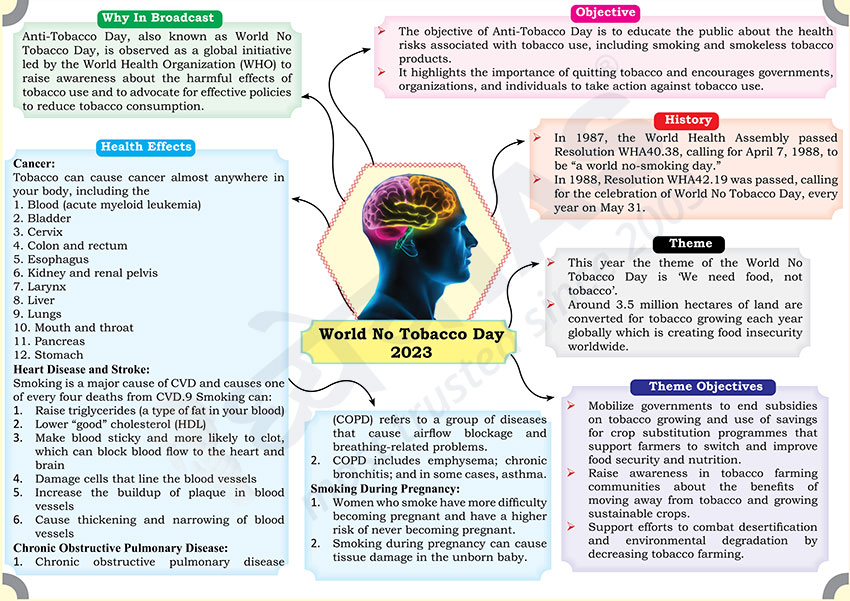Why in Broadcast?
- Anti-Tobacco Day, also known as World No Tobacco Day, is observed as a global initiative led by the World Health Organization (WHO) to raise awareness about the harmful effects of tobacco use and to advocate for effective policies to reduce tobacco consumption.
Objective
- The objective of Anti-Tobacco Day is to educate the public about the health risks associated with tobacco use, including smoking and smokeless tobacco products.
- It highlights the importance of quitting tobacco and encourages governments, organizations, and individuals to take action against tobacco use.
History
- In 1987, the World Health Assembly passed Resolution WHA40.38, calling for April 7, 1988, to be “a world no-smoking day.”
- In 1988, Resolution WHA42.19 was passed, calling for the celebration of World No Tobacco Day, every year on May 31.
Theme
- This year the theme of the World No Tobacco Day is ‘We need food, not tobacco’.
- Around 3.5 million hectares of land are converted for tobacco growing each year globally which is creating food insecurity worldwide.
Theme Objectives
- Mobilize governments to end subsidies on tobacco growing and use of savings for crop substitution programmes that support farmers to switch and improve food security and nutrition.
- Raise awareness in tobacco farming communities about the benefits of moving away from tobacco and growing sustainable crops.
- Support efforts to combat desertification and environmental degradation by decreasing tobacco farming.
Health Effects
Cancer:
Tobacco can cause cancer almost anywhere in your body, including the
- Blood (acute myeloid leukemia)
- Bladder
- Cervix
- Colon and rectum
- Esophagus
- Kidney and renal pelvis
- Larynx
- Liver
- Lungs
- Mouth and throat
- Pancreas
- Stomach
Heart Disease and Stroke:
Smoking is a major cause of CVD and causes one of every four deaths from CVD.9 Smoking can:
- Raise triglycerides (a type of fat in your blood)
- Lower “good” cholesterol (HDL)
- Make blood sticky and more likely to clot, which can block blood flow to the heart and brain
- Damage cells that line the blood vessels
- Increase the buildup of plaque in blood vessels
- Cause thickening and narrowing of blood vessels
Chronic Obstructive Pulmonary Disease:
- Chronic obstructive pulmonary disease (COPD) refers to a group of diseases that cause airflow blockage and breathing-related problems.
- COPD includes emphysema; chronic bronchitis; and in some cases, asthma.
Smoking During Pregnancy:
- Women who smoke have more difficulty becoming pregnant and have a higher risk of never becoming pregnant.
- Smoking during pregnancy can cause tissue damage in the unborn baby.







